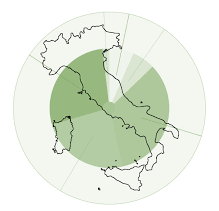Air pollution is one of the risk factors assessed by the Global Burden of Disease Study and is of great importance in population health. It actually ranks fourth in terms of impact on a global scale.
Since it is known that air quality in Italy has peculiar criticalities, especially in the Po Valley area, we evaluated how the impact estimated by the GBD for our peninsula has varied over time, from 1990 to 2019, with regard to two specific pollutants: atmospheric particulate matter ≤2.5μm (PM2.5) and ozone. “Article ”
We also considered that the burden of the two pollutants also depends on population dynamics, such as aging and epidemiological trends of noncommunicable diseases.
Estimates indicate that in 2019 PM2.5 in Italy was associated with 3.8% of deaths and 2.6% of total Disability Adjusted Life Years (DALYs), while for ozone estimates were lower: 0.5% and 0.2%, respectively.
Between 1990 and 2019, GBD estimates show a 45% decrease in the burden attributable to PM2.5, while that associated with ozone, after a 37% decrease between 1990 and 2010, showed a 45 percent increase in the following decade.
These trends reflect a decline in PM2.5 concentrations in the face of measures taken to curb emissions, such as the European directive enacted in 2008, and an initial decrease in ozone concentrations, followed by an ascent over the past decade.
By analyzing the demographic and epidemiological dynamics, it was possible to show that the aging of the population, which coincides with an increase in the fraction most susceptible to the effects of pollution, counteracts the positive effects of the decrease in concentration following the legislative measures.
Therefore, our study showed a positive impact of air quality control measures, but also pointed out that these measures need to be further strengthened, as the pollution burden remains high. Our findings therefore support the adoption of more stringent threshold values, such as those suggested by the World Health Organization.
